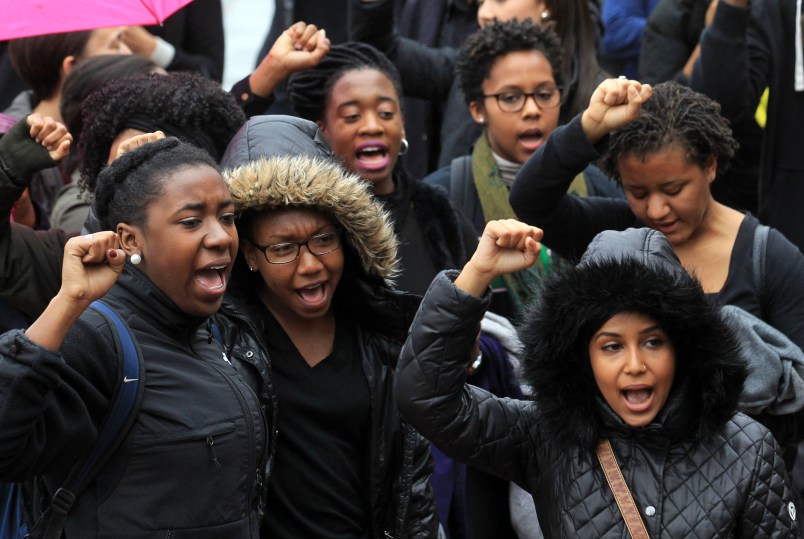I learned to swim in the Charlottesville, Virginia, public schools. My teacher was a giant, gregarious man named Mr. Byers of whom I was more than a little intimidated and a lot in awe. I can still remember the firm but caring way he comforted us as we watched the Challenger explosion live on a small television in his poolside office. In his main job as a lifeguard, Mr. Byers had demonstrated the same care; he had been struck by lightning on multiple occasions while trying to get swimmers out of pools during storms. Yet in the 1970s and 80s Charlottesville, in which both he and I lived, there were many swimming pools to which Mr. Byers, who was African-American, was not allowed or welcome.
The recent beating of University of Virginia student Martese Johnson by police and agents of Charlottesville’s ABC liquor authority has been rightly connected to many other contemporary incidents, and to the #BlackLivesMatter community and debate more broadly. Yet just as important for contextualizing and understanding the Johnson beating are Charlottesville’s specific and, in some ways unique, histories of race and segregation.
Of course, every community in the Jim Crow South was defined by many such histories. But in Charlottesville, they extended with special clarity and force well into the Civil Rights era. The Charlottesville public schools were among the last to desegregate in the United States, with the Lane and Venable elementary schools being shut down for five months in the fall of 1958 rather than admit 12 African-American schoolchildren, and the rest of the city’s schools staying segregated until September of the following year. As documented in historian Dallas Crow’s 1971 thesis, Desegregation of Charlottesville, Virginia, Public Schools, 1954-1969: A Case Study, the slow, partial, and far too often painful desegregation process went on for another decade.
Moreover, both the University of Virginia and its students were involved in the city’s parallel and even more overt struggles over communal desegregation. In February 1961, a group of 29 students and community members, white and black, attempted to buy tickets to view a film at the University Theater. After 15 whites successfully bought tickets, the first group of four black customers, including the university’s first African-American graduate student Virginius Thornton, were refused entry, as the theater did not have segregated facilities. The event sparked the city’s first prominent protest against segregation, one that would be followed by many more such controversies and responses.
Even more violent was the response to one of the city’s first restaurant sit-ins, at local favorite Buddy’s, on Memorial Day weekend in 1963. The first mixed-race group of protesters who tried to get service at Buddy’s were ignored; the following day, the second were confronted with violent resistance, with an African-American minister slapped by two whites, and UVA faculty member and civil rights historian Paul Gaston punched in the face when he tried to phone for help. Buddy’s would remain segregated until the Civil Rights Act was passed in July 1964, when the restaurant closed rather than serve African-American patrons.
A century and a half before Virginius Thornton became UVA’s first black grad student, Mr. Jefferson’s University was constructed by slave labor, a hidden history that only recently has begun to be featured on some of the university’s tours and promotional materials. Yet we do not have to travel to the slave South of the antebellum era to find histories of racial division and violence in either Charlottesville or its university: they are part of every period and every place, including, as we have seen far too clearly in recent days, the bars on the Corner in our own 21st century moment.
Ben Railton is an Associate Professor of English at Fitchburg State University and a member of the Scholars Strategy Network.







A good article. But why was Mr. Byers unwelcome at so many pools if he wasn’t African-American? Was that a typo, or did I just miss a crucial adjective somewhere?
Yikes, thanks for noticing that. It is a typo, as Mr. Byers was indeed African American. I’ll see if I can get that corrected.
Also wanted to note a great source for some of this piece, this 2004 cover article in Cville’s alternative newspaper The Hook (since renamed the Cville Weekly):
http://www.readthehook.com/94922/cover-long-and-winding-road-city-residents-recall-integration-battles
Thanks Ben - I was born in Charlottesville in 1962 and lived there till I left for college. We lived near Ivy, my father was a professor and research scientist at the medical school, and I remember some of the tense times as desegregation took hold. As a child I recall asking my mother if it would be OK to bring one of my African American friends to our pool. She got a funny look and said, “no” but looked pained to have to say that. When I pressed her she told me that, “black people weren’t allowed there” so I told her I would not be going back any more.
I’m not writing that to demonstrate any moral superiority over my mother’s generation but to acknowledge that you and I were born at a time when the culture was shifting when it came too race relations. As a teenager I did farm work in the summers and there was still a racial divide among the field hands. You could see and feel the tolerance divide between the old, rural South and the university community. In many ways the latest incident on “the corner” shows that the divide remains.
Atlanta, which has an undeserved rep as having been “moderate” on race closed its swimming pools in the late 50s and early 60s (as did its suburbs). When I moved there in the 90s, I was struck at the lack of places to swim in a place where even the lifelong residents find summer to be miserable.
Have to share this story I just found on Mr. Byers’ retirement last fall (!):
http://www.newsplex.com/home/headlines/Charlottesville-Swim-Teacher-Retires-280589412.html